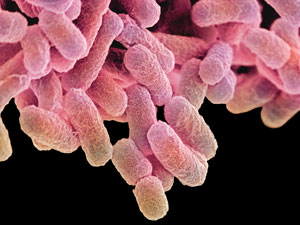Aug. 25, 2017 Research Highlight Biology
E. coli tripeptide production model reveals surprising complexity
The incredible complexity of a single-celled organism is revealed by a computer model of protein production
 Figure 1: Using a computer simulation, RIKEN researchers have modeled how the single-celled bacterium Escherichia coli produces a small protein. © Science Photo Library - STEVE GSCHMEISSNER/Getty
Figure 1: Using a computer simulation, RIKEN researchers have modeled how the single-celled bacterium Escherichia coli produces a small protein. © Science Photo Library - STEVE GSCHMEISSNER/Getty
Creating a small protein in a simple organism is a breathtakingly complex undertaking, a new computer modeling has revealed. RIKEN scientists have mapped how the concentrations of more than 240 compounds vary with time when the tiny single-celled bacterium Escherichia coli makes a small protein1. They found that while all the concentrations eventually plateau, they do not reach those plateaus in a smooth, linear fashion; rather, they exhibit temporary periods of stability—known as quasi-stationary states—followed by periods of sudden change. This finding could provide a powerful way to explore the dynamics of complex systems.
The process of producing the tripeptide Met–Gly–Gly, a protein made up of just three amino acids, uses 27 starting chemicals that make 241 products and intermediate compounds through a staggering 968 reactions. Determining how the concentrations of these 241 compounds vary with time would seem to be a hopelessly complex task, but that is what Yoshihiro Shimizu at RIKEN Quantitative Biology Center and co-workers have succeeded in doing.
The team constructed a large-scale model of the protein synthesis in E. coli. To do this, they scoured the literature for experimental reaction rates of the reactions involved in the synthesis. They then made a simulation of the first 15 minutes of the process, which accurately reproduced the kinetics of the tripeptide synthesis.
The results yielded two surprises. The first was that the synthesis rate of the tripeptide was remarkably robust against changes in the parameters used in the model. “When we varied the kinetic parameters in the simulation, we found that many changes in the parameters do not affect the synthesis rate of the tripeptide,” says Shimizu. “This suggests that only a few parameters determine the synthesis rate of the product, even in such a large-scale reaction network.”
The second unexpected finding was that although the synthesis of the tripeptide increased linearly over the 15-minute period, this masked surprising fluctuations in the concentrations of many of the other compounds. In particular, their concentrations would reach stable values for a while, only to later change dramatically.
“The process involved collapse and regrowth of clusters of compounds in a quasi-stationary state,” explains Shimizu. “Network collapse occurred at two time points as a result of changes in the supply of recyclable substrates and the presence of a reaction cascade bottleneck.” This finding suggests that focusing on these quasi-stationary states might be a helpful way to analyze complex reaction dynamics.
The team now intends to obtain experimental data to both confirm the accuracy of their simulation and to improve it.
Related contents
References
- 1. Matsuura, T., Tanimura, N., Hosoda, K., Yomo, T. & Shimizu, Y. Reaction dynamics analysis of a reconstituted Escherichia coli protein translation system by computational modeling. Proceedings of the National Academy of Sciences USA 114, E1336–E1344 (2017). doi: 10.1073/pnas.1615351114
